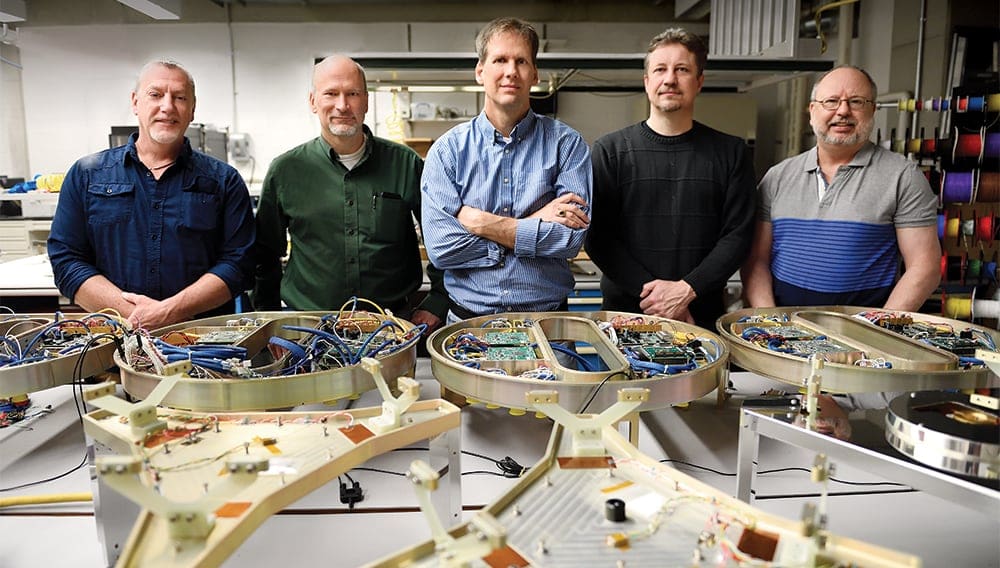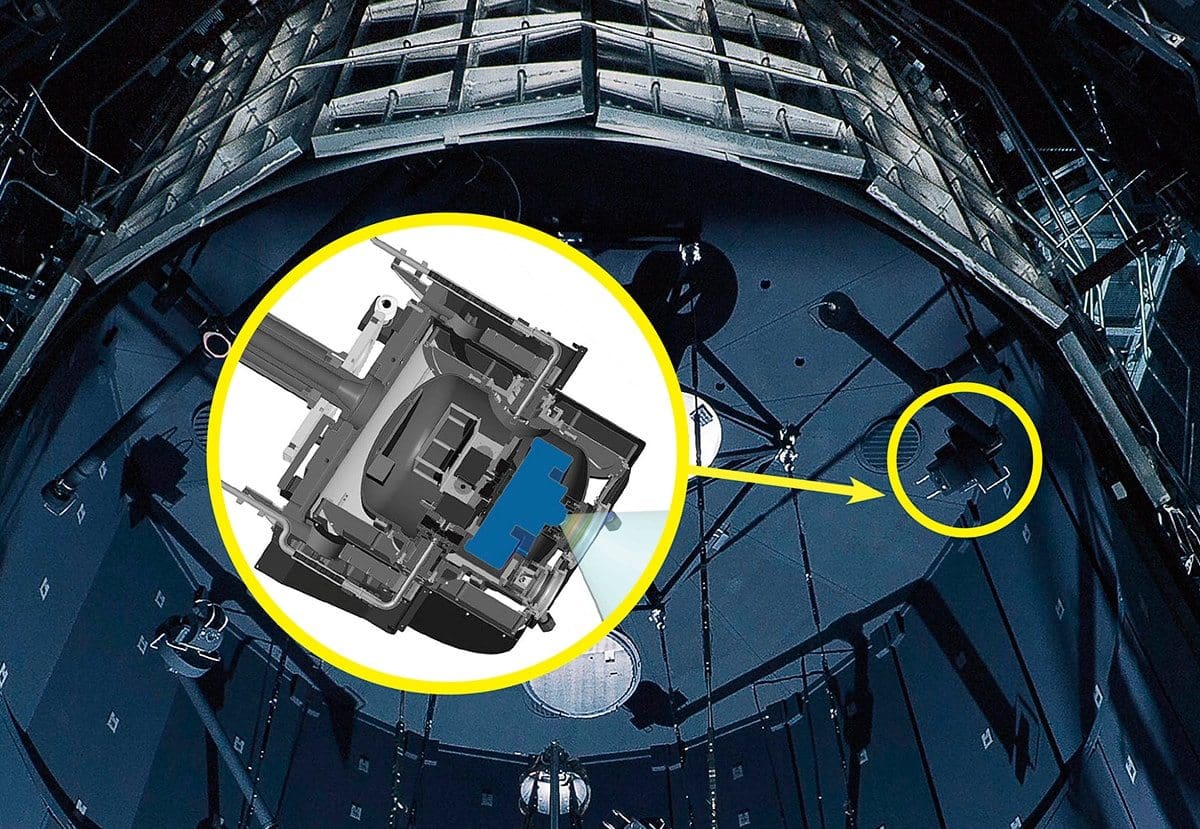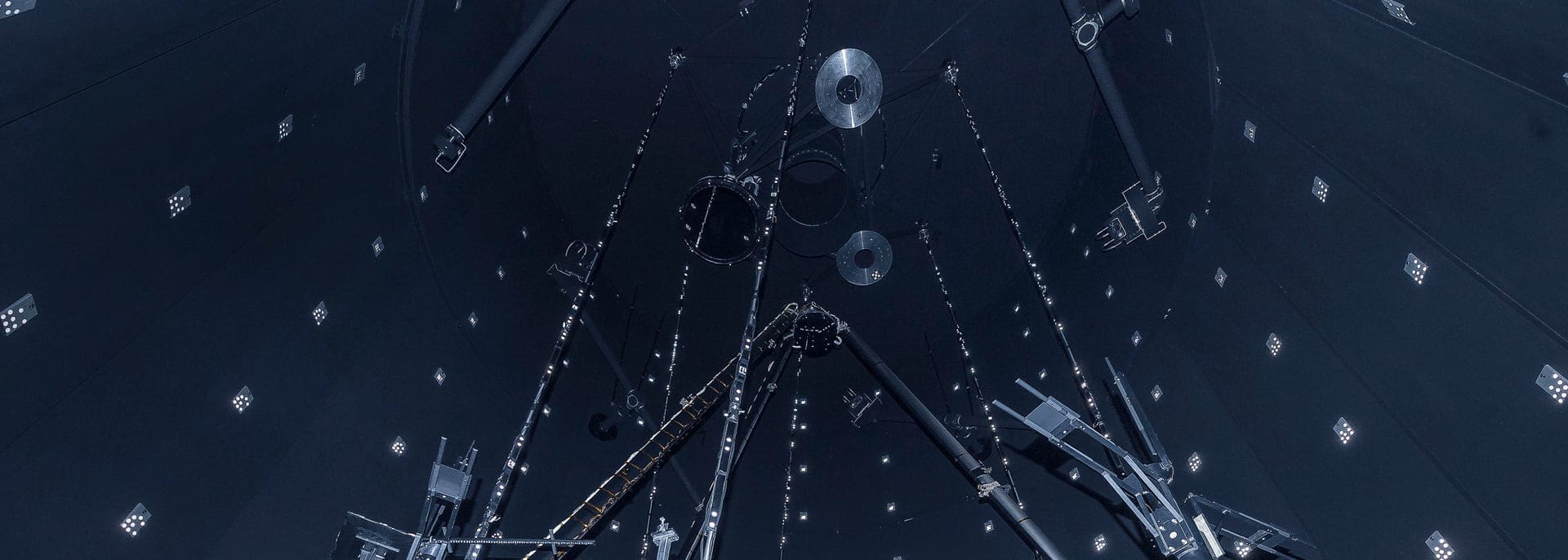Last summer in Test Chamber A of the Johnson Space Center in Houston, Texas, it got cold. Real cold. Minus 424 degrees Fahrenheit for nearly 100 days to be exact. Other atmospheric conditions were harsh, too. Over the course of a week, NASA engineers pumped all the air out of the nine-story-tall, 55-foot-wide metal cylinder, creating an inhospitable vacuum.
At the bottom of the massive chamber, once used to train astronauts for the Apollo missions, lay the $8.8 billion James Webb Space Telescope (JWST), which will be used to observe some of the most distant objects and events in the universe, such as the formation of the first galaxies. JWST will be operated out of the Space Telescope Science Institute on the Johns Hopkins Homewood campus. NASA engineers were trying to learn how the telescope, the successor to the Hubble Space Telescope, would perform in space-like conditions prior to the instrument’s launch, sometime in 2020. The space agency does not want a repeat of the errors that plagued Hubble, when astronomers discovered a flaw in the telescope’s primary mirror array, only after it was in orbit.
All that explains why months prior to this deep freeze, Randy Hammond, Stephen Smee, Steve Hope, and Joe Orndorff—all of the Krieger School of Arts and Sciences—were standing on scaffolding 40 feet up, wearing white clean suits, headlamps, and oxygen monitors, as they worked to install several high-tech cameras to be used in a series of tests on the telescope.
The team is part of the Krieger School’s Instrument Development Group (IDG), a service center of sorts within the Department of Physics and Astronomy. IDG members routinely develop precision instruments for scientific research at Johns Hopkins in the fields of astronomy, condensed matter physics, high energy physics, and biomedical research as well as for private industry and government agencies.

Al Harding, Randy Hammond, Stephen Smee, Steve Hope, and Joseph Orndorff.
For NASA’s new telescope, they were tasked with developing a system of four cameras to be suspended high above JWST on 21-foot-long, rotating booms to record thermal contraction and expansion of the telescope’s structure during the 100-day test.
These cameras weren’t your normal point-and-shoot variety, of course, but $200,000 toaster-sized digital picture-taking machines, traditionally employed in the field of photogrammetry, the science of using photography to measure distances. In the pitch black test chamber, the four cameras would each fire a flash every 20 seconds, illuminating small retro-reflective targets placed throughout the chamber and along the surfaces of the telescope. Researchers could then use the data as a precise tape measure to determine how the equipment shifted in response to changes in temperature and pressure. (In space, any shift of the telescope’s mirror or other mechanisms could throw its measurements way off.) The cameras could detect any movement down to 100 microns, or the thickness of a sheet of paper.
Mechanically, electrically, it’s a challenge. At minus 400 degrees, materials do funny things. They can become electrically conductive, properties change. You can’t use traditional lubricants because you’re in a vacuum. If you just greased things up, [the grease] would probably flake off and land on the $9 billion telescope…”
—Randy Hammond, Mechanical Engineer
The challenge for the IDG team involved working out the delicate balance of keeping the cameras warm enough to function but cold enough so that any heat generated by the camera equipment wouldn’t interfere with the infrared detecting systems of the telescope. What’s more, the large booms had to be able to rotate 360-degrees on command, and the cameras needed to tilt and pan. “Mechanically, electrically, it’s a challenge,” says Hammond, senior mechanical engineer. “At minus 400 degrees, materials do funny things. They can become electrically conductive, properties change. You can’t use traditional lubricants because you’re in a vacuum. If you just greased things up, [the grease] would probably flake off and land on the $9 billion telescope, which is not a good thing.”
Working in the basement of the Bloomberg Center, they developed four protective cylindrical aluminum canisters the size of microwave ovens to house four cameras. Then they blanketed the canisters with thermal insulation, surrounded that with shielding, and implemented a network of plumbing for thermal control: Through one set flowed relatively warm nitrogen gas to keep the camera comfortable. Another set carried chilled gaseous helium to keep the canister shielding as cold as the test chamber and invisible to the telescope. The nitrogen gas conditioning system—a fairly complex system in its own right—involved using a motorcycle intercooler purchased off eBay and a modified diaphragm pump traditionally used for sewage aeration to purge the lines.
For a task that seems simple on the surface—design a pan/tilt head for a camera—it took a tremendous amount of ingenuity to pull off all these subsystems. You bundle all that stuff together and you’ve got yourself a very fancy, NASA-approved system.”
—Stephen Smee, Engineering Manager

A rendering of one of the four cameras, each located inside of a protective cylindrical aluminum canister. The cameras had to be able to operate in the extreme temperature and pressure in space during the 100 days of testing.
The cameras’ flash units, which NASA specified had to be capable of exceeding 200,000 bursts, were originally fashioned from old Nikon strobes, and after failing prematurely, were redesigned from scratch, implementing custom-made quartz flash tubes and tiny internal cooling fans. “For a task that seems simple on the surface—design a pan/tilt head for a camera—it took a tremendous amount of ingenuity to pull off all these subsystems,” says Smee, a mechanical engineer by training and director of the group. “You bundle all that stuff together and you’ve got yourself a very fancy, NASA-approved system. No duct tape was used.”
As part of the tests, the team also developed a life-support canister to protect a laser-based measuring device, which was used to gauge changes to the telescope’s primary mirror’s center of curvature.
While the tests were happening, Orndorff stayed in Houston to operate the team’s camera systems, at one point, having to abandon his hotel room due to rising waters from Hurricane Harvey.
The Johns Hopkins team was unique in that nearly every group that participated in the JWST tests was from major aerospace subcontractors, not academic institutions. The IDG’s photogrammetry system performed without flaw. “We were receiving progress reports every day, and you just didn’t want to see your equipment show up [as problematic],” says Hammond.
On the contrary, NASA was more than happy with IDG’s work. “This was possibly the most complicated optical test NASA had ever done, and the photogrammetry system worked great,” says Lee Feinberg, JWST’s optical element manager at NASA’s Goddard Space Flight Center. “We were extremely pleased with its performance.”
The significance of their contribution is not lost on the IDG engineers. “It was definitely a thrill to be so close to this telescope,” says Smee. “It’s the next piece of history comparable to Hubble.”◾
This timelapse video released by NASA shows the cryogenic chamber that is filled with JHU-made equipment to simulate the extreme cold of space that JWST will encounter.
More JHU Involvement in JWST
In March, leaders of the James Webb Space Telescope announced their selection of 13 teams to lead the Early Release Science Programs. Among them is a team led by physics and astronomy Professor Nadia Zakamska; recent JHU postdoc researcher Dominika Wylezalek; and Professor Sylvain Veilleux from University of Maryland, College Park. The team plans to study galactic winds launched by supermassive black holes. The Early Release Science Programs will take place in the first few months of the operation of the telescope to test the capabilities of the instruments and provide the community with cutting-edge datasets to analyze and use in planning further observations. The Early Release Science teams will lead development of analysis tools to optimize the use of the data from the telescope and provide those tools to the astronomical community.

